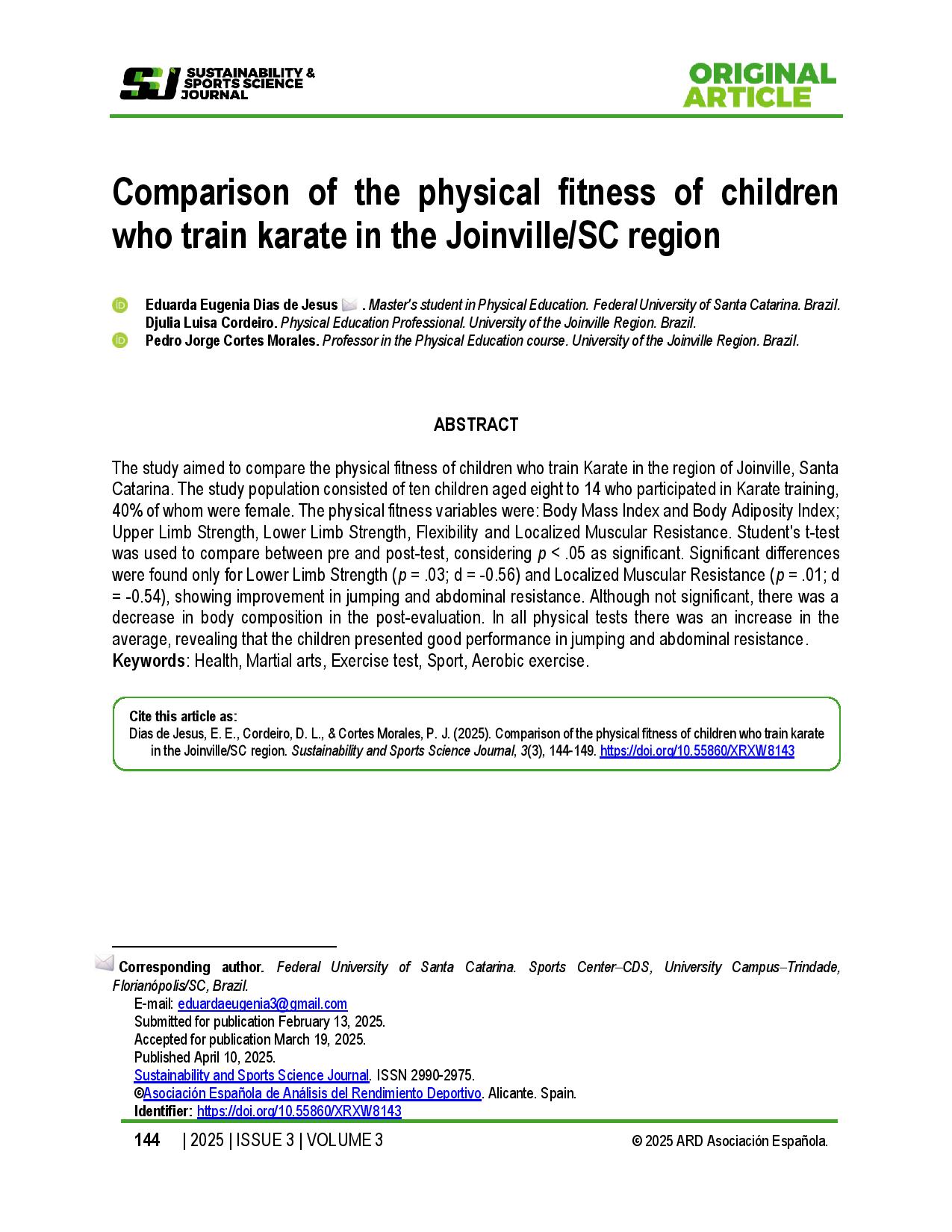Comparison of the physical fitness of children who train karate in the Joinville/SC region
Main Article Content
Abstract
The study aimed to compare the physical fitness of children who train Karate in the region of Joinville, Santa Catarina. The study population consisted of ten children aged eight to 14 who participated in Karate training, 40% of whom were female. The physical fitness variables were: Body Mass Index and Body Adiposity Index; Upper Limb Strength, Lower Limb Strength, Flexibility and Localized Muscular Resistance. Student's t-test was used to compare between pre and post-test, considering p < .05 as significant. Significant differences were found only for Lower Limb Strength (p = .03; d = -0.56) and Localized Muscular Resistance (p = .01; d = -0.54), showing improvement in jumping and abdominal resistance. Although not significant, there was a decrease in body composition in the post-evaluation. In all physical tests there was an increase in the average, revealing that the children presented good performance in jumping and abdominal resistance.
Article Details

This work is licensed under a Creative Commons Attribution-NonCommercial-ShareAlike 4.0 International License.
References
Abuzayda, A. (2024). The Effect of Training Using Medicine Balls on the Muscular Strength of Children Aged (9-12) Years Practicing Karate in the Gaza Strip. An-Najah University Journal for Research - B (Humanities), 38(11), 2087-2108. https://doi.org/10.35552/0247.38.11.2286
Arslan, Y., Yavaşoğlu, B., Beykumül, A., Pekel, A. Ö., Suveren, C., Karabulut, E. O., Ayyıldız Durhan, T., Çakır, V. O., Sarıakçalı, N., Küçük, H., & Ceylan, L. (2024). The effect of 10 weeks of karate training on the development of motor skills in children who are new to karate. Frontiers in Physiology, 15. https://doi.org/10.3389/fphys.2024.1347403
Gaya, A. R., Gaya, A., Pedretti, A., & Mello, J. (2021). Projeto Esporte Brasil: Manual de medidas, testes e avaliações. (Universidade Federal do Rio Grande do Sul, Ed.; 5th ed.).
Gillison, F. B., Standage, M., Cumming, S. P., Zakrzewski-Fruer, J., Rouse, P. C., & Katzmarzyk, P. T. (2017). Does parental support moderate the effect of children's motivation and self-efficacy on physical activity and sedentary behaviour? Psychology of Sport and Exercise, 32, 153-161. https://doi.org/10.1016/j.psychsport.2017.07.004
Ivanović, M., & Ivanović, U. (2022). The relations between body mass index, motor skills, and physical self-concept in determining physical activities of junior karatekas. Exercise and Quality of Life, 14(1), 25-32. https://doi.org/10.31382/eqol.220603
Jesus, E. E. D. De, Bernardi, I. T. D. B., Brasilino, F. F., Rosa, A., Costa, A. B. H. D. C., & Morales, P. J. C. (2025). Relação entre Aptidão Física e Composição Corporal dos Atletas Adolescentes 85 de Voleibol. Fiep Bulletin - Online, 95(1), e7093. https://doi.org/10.16887/jmc9wr59
Krkeljas, Z., & Kovac, D. (2020). Relationship between functional movement screen, athletic and karate performance in adolescents. Human Movement, 22(2), 16-21. https://doi.org/10.5114/hm.2021.100009
Nahas, M. V. (2017). Atividade física, saúde e qualidade de vida : conceitos e sugestões para um estilo de vida ativo (Ed. do Autor, Ed.; 7th ed.).
Stamenković, A., Manić, M., Roklicer, R., Trivić, T., Malović, P., & Drid, P. (2022). Effects of Participating in Martial Arts in Children: A Systematic Review. Children, 9(8), 1203. https://doi.org/10.3390/children9081203
Sun, M.-S., & Kim, C.-G. (2022). Effects of Taekwondo Training on Body Composition and Salivary Cytokines in Childhood obesity. Journal of Coaching Development, 24(2), 201-207. https://doi.org/10.47684/jcd.2022.06.24.2.201




